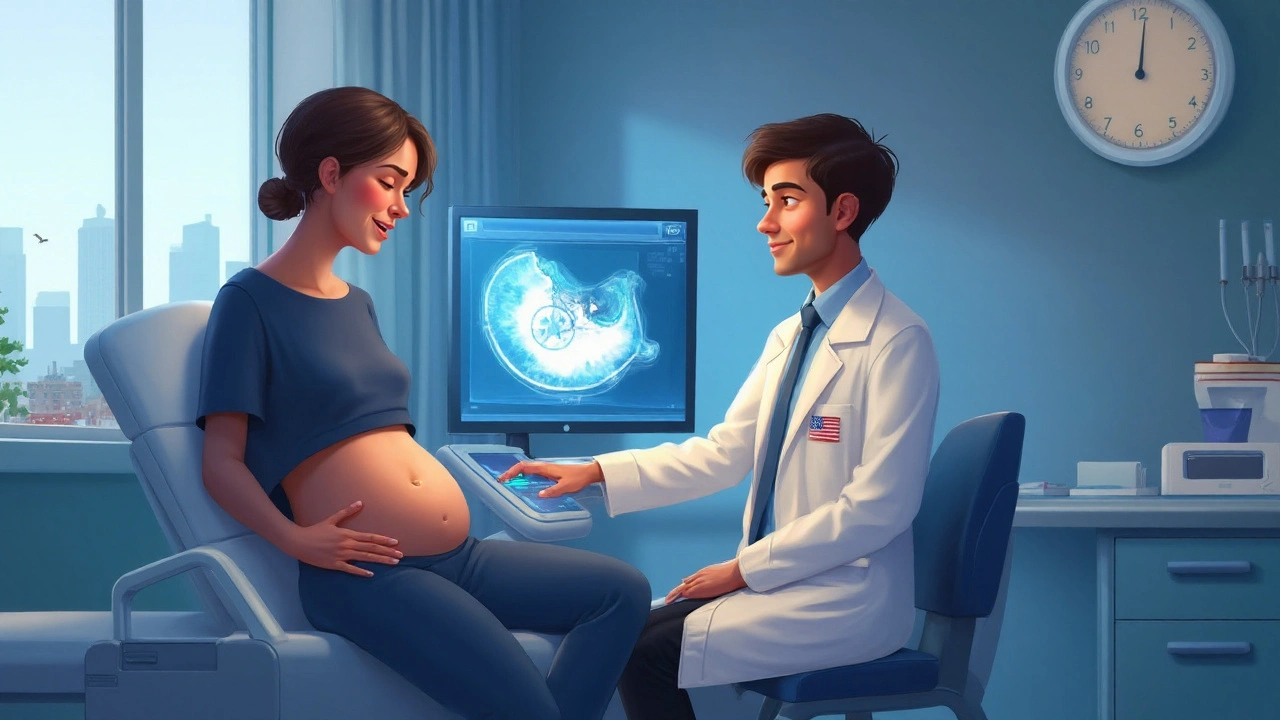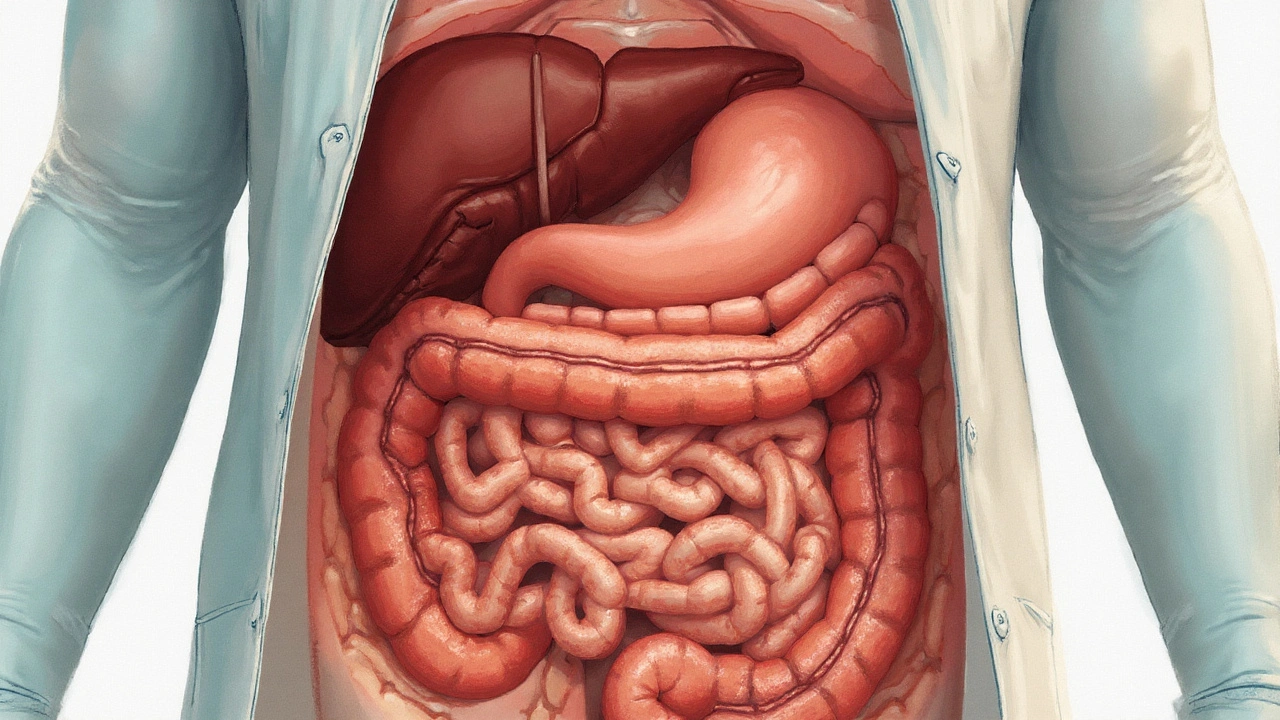Pancreatic Duct Blockage Symptom Checker
Pancreatic duct blockage is a condition where the main conduit that carries digestive enzymes from the pancreas to the duodenum becomes obstructed. This can stem from gallstones, scar tissue, or tumors, and it directly threatens normal digestive health.
The pancreatic duct blockage is more than a nuisance; it can cripple the entire digestive cascade. When the duct is clogged, enzymes never reach the small intestine, leaving food partially broken down and nutrients unabsorbed. Below, we unpack how the blockage works, why it matters, and what you can do about it.
How the Pancreas and Its Duct Normally Operate
Pancreas is a dual‑function organ that produces hormones for blood‑sugar control and releases digestive enzymes into the gastrointestinal tract. Its exocrine portion funnels enzyme‑rich fluid through the main pancreatic duct into the duodenum.
Pancreatic enzymes are a blend of amylase, lipase, and proteases that break down carbs, fats, and proteins respectively. Together they ensure that macronutrients become absorbable molecules.
The duct terminates at the sphincter of Oddi, a muscular valve that coordinates the release of bile and pancreatic juice. Under normal conditions, the sphincter relaxes with each meal, allowing a surge of enzymes to meet the incoming chyme.
What Triggers a Blockage?
Several culprits can choke the duct:
- Gallstones that migrate from the gallbladder into the pancreatic duct (often called biliary pancreatitis).
- Fibrotic scar tissue from chronic inflammation, most commonly seen in Chronic pancreatitis, a long‑standing inflammatory disease that produces calcium deposits and fibrosis.
- Malignant growths such as Pancreatic cancer, especially tumors located at the head of the pancreas where the duct exits.
- Strictures forming after repeated episodes of Pancreatitis, an acute inflammation that can cause swelling and subsequent scarring.
- Congenital anomalies like pancreas divisum, where the ducts fail to fuse properly, creating a predisposition to blockage.
Digestive Consequences of a Blocked Duct
When enzymes are trapped, three major problems arise:
- Malabsorption: Fat‑soluble vitamins (A, D, E, K) and essential fatty acids are poorly absorbed, leading to deficiencies.
- Steatorrhea: Unprocessed fats leave the stool greasy, bulky and foul‑smelling.
- Exocrine pancreatic insufficiency (EPI): The pancreas can no longer meet the body’s enzymatic demand, a condition formally defined as Exocrine pancreatic insufficiency with a description="reduced secretion of digestive enzymes causing chronic nutrient loss">.
Beyond the gut, prolonged EPI can trigger weight loss, anemia, and weakened immunity. Moreover, the pressure buildup behind the blockage may force pancreatic juices to back‑leak into surrounding tissue, igniting painful inflammation-another bout of pancreatitis.

How Doctors Detect a Blockage
Diagnosis blends symptom review with imaging and functional tests:
- Blood labs: Elevated amylase/lipase hint at recent pancreatic injury.
- Fecal fat analysis: Quantifies malabsorption; >7g fat per 24h signals steatorrhea.
- Magnetic Resonance Cholangiopancreatography (MRCP): Non‑invasive MRI view of the ductal system, excellent for spotting strictures.
- Endoscopic Retrograde Cholangiopancreatography (ERCP) is both diagnostic and therapeutic. In this procedure, a side‑viewing endoscope accesses the duodenum, injects contrast, and visualizes the duct under X‑ray.
Endoscopic Retrograde Cholangiopancreatography (ERCP) is a minimally invasive technique that allows doctors to both see and intervene in the pancreatic duct.
When ERCP confirms a blockage, clinicians often place a Pancreatic stent, a tiny tube that props the duct open and restores enzyme flow.
Treatment Roadmap
Therapy follows three tracks: removing the obstruction, supporting digestion, and preventing recurrence.
| Cause | Typical Prevalence | Key Symptom | Preferred Diagnostic Test | First‑Line Treatment |
|---|---|---|---|---|
| Gallstones | ≈20% of adult cases | Sudden epigastric pain after fatty meals | ERCP with contrast | Stone extraction + stent placement |
| Chronic pancreatitis (fibrosis) | ≈15% of chronic cases | Persistent dull pain, weight loss | MRCP | Stent insertion, enzyme replacement |
| Pancreatic cancer | ≈5% of duct obstructions | Jaundice, new‑onset diabetes | CT scan + ERCP biopsy | Surgical resection or palliative stenting |
| Scar tissue after pancreatitis | ≈10% of post‑acute cases | Recurrent pain, elevated enzymes | MRCP + endoscopic ultrasound | Endoscopic dilation, stent |
Beyond procedural fixes, patients often need Pancreatic enzyme replacement therapy (PERT), a regimen of prescribed lipase, amylase and protease capsules taken with meals to mimic natural secretion.
For mild cases where the blockage resolves spontaneously or after stone passage, dietary tweaks can mitigate symptoms.
Nutrition & Lifestyle Strategies
- Low‑fat diet: Reducing fat to < 30g per day eases the demand on the pancreas.
- Medium‑chain triglycerides (MCTs): Easily absorbed fats that bypass pancreatic lipase.
- Vitamin supplementation: Fat‑soluble vitamins A, D, E, K should be given in water‑soluble preparations.
- Avoid alcohol: Even moderate intake can exacerbate inflammation and scar formation.
- Small, frequent meals: Keeps enzyme demand steady and lessens pressure spikes in the duct.
Patients on PERT should experiment with timing-ideally the enzyme capsule should be swallowed 15‑30 minutes before eating to allow it to mix with food as it enters the duodenum.
Related Concepts and Future Directions
Understanding duct blockage links to broader topics such as:
- Bile duct obstruction-another conduit that can share causes like gallstones.
- Advances in Endoscopic ultrasound (EUS)-provides high‑resolution images and can guide fine‑needle biopsies.
- Genetic risk factors for Hereditary pancreatitis, where mutated PRSS1 genes predispose to early‑onset fibrosis.
Researchers are testing biodegradable stents that dissolve after a few weeks, potentially eliminating the need for repeat endoscopies. Meanwhile, secretin‑enhanced MRCP promises clearer duct visualization without ionizing radiation.

Frequently Asked Questions
What are the first signs of a pancreatic duct blockage?
Typical early clues include sudden upper‑abdominal pain after a fatty meal, greasy or floating stools, and unintentional weight loss. Blood tests may show mildly elevated lipase, but imaging is required for confirmation.
Can lifestyle changes prevent a blockage?
Yes. Avoiding excessive alcohol, maintaining a healthy weight, and limiting high‑fat meals reduce the risk of gallstone formation and chronic inflammation, both common precursors to duct obstruction.
Is surgery ever needed?
Surgery is considered when a tumor blocks the duct, when stones cannot be cleared endoscopically, or when repeated stenting fails. Options range from pancreaticoduodenectomy (Whipple) for cancer to less invasive laparoscopic drainage procedures.
How effective is pancreatic enzyme replacement therapy?
When dosed correctly (usually 25,000-40,000 IU of lipase per meal), PERT restores fat absorption to >90% of normal levels, relieves steatorrhea, and stabilizes weight.
What follow‑up is required after an ERCP with stent placement?
Patients should return for imaging (usually repeat MRCP) in 4-6 weeks to ensure the stent remains patent. The stent may be removed or exchanged depending on the underlying cause.


Roxanne Porter
September 22, 2025 AT 22:40Pancreatic duct obstruction is a clinically significant condition that can compromise the delivery of digestive enzymes to the duodenum. When the duct is blocked, pancreatic secretions accumulate, leading to increased intraductal pressure. This pressure can cause pain that is often described as sharp or burning in the upper abdomen, particularly after a fatty meal. In addition to pain, patients may experience steatorrhea, which manifests as bulky, foul‑smelling, and float‑inducing stools. The malabsorption of fats also contributes to unintended weight loss and deficiencies in fat‑soluble vitamins A, D, E, and K. Laboratory evaluation typically reveals elevated serum lipase and amylase, although these markers can be modestly increased in chronic cases. Imaging modalities such as magnetic resonance cholangiopancreatography (MRCP) provide a non‑invasive view of the ductal anatomy and are valuable for identifying strictures or stones. Endoscopic retrograde cholangiopancreatography (ERCP) serves a dual purpose by confirming the diagnosis and allowing therapeutic interventions, including stone extraction and stent placement. The placement of a pancreatic stent restores the patency of the duct, thereby facilitating the flow of enzymes into the gastrointestinal tract. For many patients, adjunctive pancreatic enzyme replacement therapy (PERT) is required to achieve adequate nutrient absorption. The dosage of PERT is typically individualized, ranging from 25,000 to 40,000 IU of lipase per main meal, and should be taken in close temporal proximity to food ingestion. Lifestyle modifications, such as adherence to a low‑fat diet and abstention from alcohol, help reduce the risk of recurrent obstruction. In cases where the underlying cause is malignant, surgical options such as pancreaticoduodenectomy may be considered, often in conjunction with palliative stenting. Follow‑up imaging after stent placement, usually performed at four to six weeks, is essential to assess ductal clearance and stent patency. Early recognition and multidisciplinary management are key to preventing long‑term complications such as chronic pancreatitis, malnutrition, and diminished quality of life.
Jonathan Mbulakey
September 22, 2025 AT 23:40The interplay between gallstones and duct blockage is a classic example of mechanical obstruction that triggers pancreatic pain. A low‑fat diet can blunt the acute episodes by reducing the workload on the pancreas. Imaging still remains the cornerstone for distinguishing stone‑related blockage from fibrotic strictures.
Warren Neufeld
September 23, 2025 AT 00:40If you notice greasy stools and weight loss, it’s a sign that the pancreas isn’t delivering enzymes properly. A doctor will likely check lipase levels and order an MRCP to see the duct. Starting enzyme pills early can keep the nutrition on track while the blockage is being dealt with.
Deborah Escobedo
September 23, 2025 AT 01:40Stent placement often relieves the pressure quickly.
Dipankar Kumar Mitra
September 23, 2025 AT 02:40Don’t think you can ignore that gnawing pain after a burger; it’s your pancreas screaming for help. Get an ERCP done pronto before the situation spirals.
Tracy Daniels
September 23, 2025 AT 03:40When prescribing pancreatic enzyme replacement, timing is crucial – the capsule should be swallowed about 20 minutes before the meal so it mixes with incoming chyme.
Adjust the dose based on the fat content of each meal; higher‑fat dishes may need a larger unit count.
Monitoring weight and stool consistency helps fine‑tune the regimen over time.
Don’t forget to supplement vitamins A, D, E, and K in water‑soluble forms to counter malabsorption.
Stay consistent and you’ll see steady improvement 🙂
Hoyt Dawes
September 23, 2025 AT 04:40Honestly, this whole “blockage” narrative feels like re‑hashing old textbooks without any fresh insight.
Jeff Ceo
September 23, 2025 AT 05:40While the tone may be casual, the medical facts remain clear: early intervention prevents irreversible damage.
David Bui
September 23, 2025 AT 06:40Look, if you’re still slamming down deep‑fried foods after a diagnosis, you’re basically signing your own medical ticket. The pancreas isn’t a rubber band you can stretch forever. Cut the grease, use MCT oil, and actually listen to the guidelines – otherwise you’ll be back in the ER sooner than you think.
Alex V
September 23, 2025 AT 07:40Oh sure, just keep eating bacon and hope the stent does the heavy lifting – brilliant plan… not.
Robert Jackson
September 23, 2025 AT 08:40If anyone thinks this advice is optional, they clearly haven’t read the guidelines, mate.